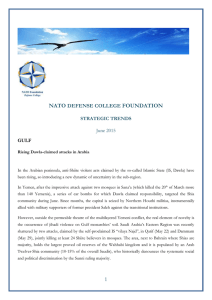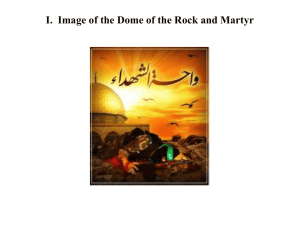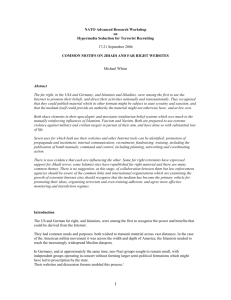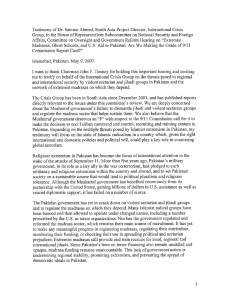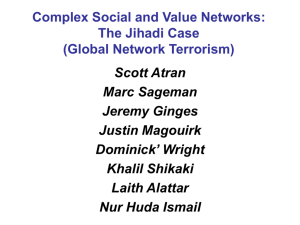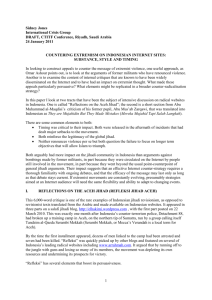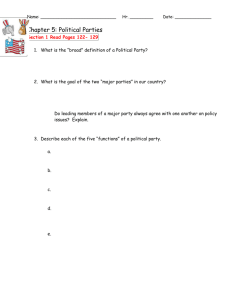STATEMENT OF JARRET BRACHMAN BEFORE THE HOUSE ARMED SERVICES COMMITTEE
advertisement
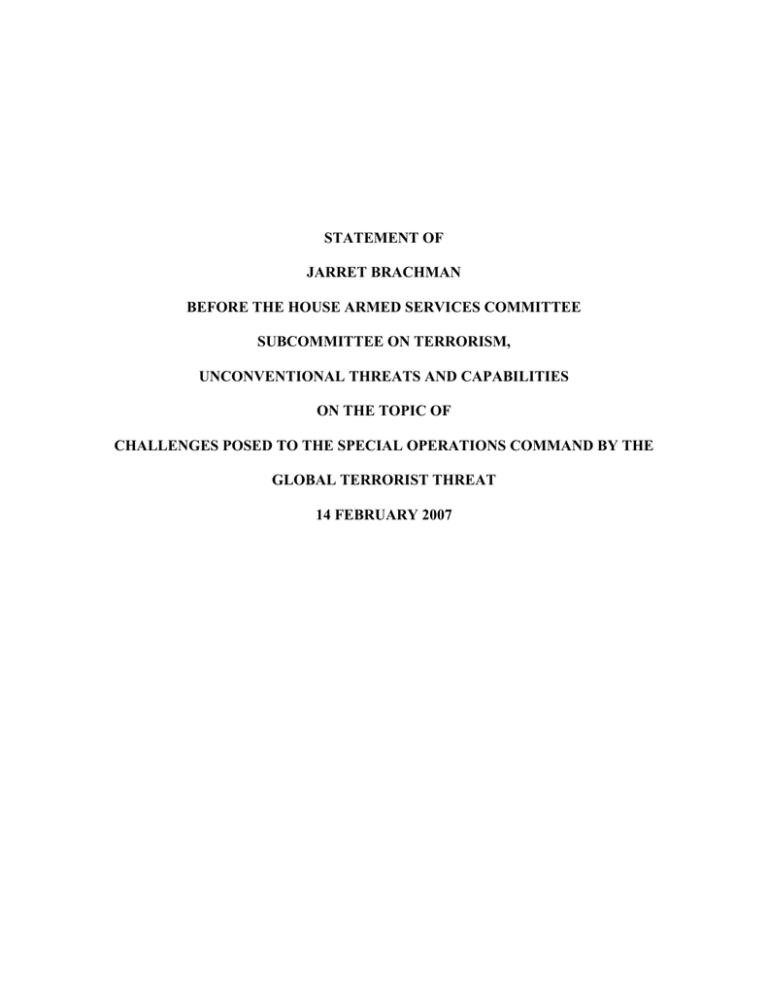
STATEMENT OF JARRET BRACHMAN BEFORE THE HOUSE ARMED SERVICES COMMITTEE SUBCOMMITTEE ON TERRORISM, UNCONVENTIONAL THREATS AND CAPABILITIES ON THE TOPIC OF CHALLENGES POSED TO THE SPECIAL OPERATIONS COMMAND BY THE GLOBAL TERRORIST THREAT 14 FEBRUARY 2007 STATEMENT OF JARRET BRACHMAN 1 BEFORE THE HOUSE ARMED SERVICES COMMITTEE SUBCOMMITTEE ON TERRORISM, UNCONVENTIONAL THREATS AND CAPABILITIES 14 FEBRUARY 2007 Chairman Smith, Congressman Thornberry, distinguished members of the Subcommittee: It is an honor and privilege to discuss with you the future challenges facing the nation by the global Jihadi Movement. My comments will focus on fighting the ideological and strategic dimensions of this war. I will begin by mapping the emergent trends with regards to the Jihadi Movement’s ideology, then review some approaches that may improve our ability to combat those trends in the short-term, and finally conclude by proposing the establishment of a new research center, which I believe would further bolster our ability to lead us to long-term victory against the Jihadi Movement. Emergent Trends Our principal enemy in the global war on terrorism is the Jihadi Movement, which, at the most basic level, consists of like-minded individuals and groups worldwide who are loosely bound by a shared ideological worldview and a collectively held identity.2 Many of the Jihadi Movement’s participants can be considered, without question, terrorists, insurgents and enemy combatants and, therefore, dealt with as such. That said, there are a growing number of participants in the Jihadi Movement that do not fit into our existing characterizations. This category includes Jihadi-minded webmasters, graphics designers, social activists, software engineers, Internet bloggers and translators. 1 This testimony represents the personal opinion of the author and not necessarily the opinion of the U.S. Military Academy or any other government agency. 2 In 2005, Quintan Wiktorowicz published a compelling book entitled, Radical Islam Rising: Muslim Extremism in the West (Rowmand and Littlefield), in which he demonstrates how the theoretical and methodological insights provided by Social Movement Theory can be usefully applied to understanding the challenges of radical Islamic activism conceived as a movement. 2 In the past three years, our enemy’s chief priority seems to be giving more people from more places more ways and more reasons to join their Movement, whether that be in the streets of Baghdad or on websites in cyberspace. In so doing, they have pioneered new tactics, techniques and procedures on the battlefield and they have learned to leverage technology in more creative and sophisticated ways online.3 We have seen Jihadi activists develop heightened media savvy in terms of using propaganda for strategic image manipulation. Jihadi propagandists, whom we still know relatively little about, have improved their abilities to spin the unpopular aspects of their Movement – attacks that kill Muslim women, children and the elderly, for instance – while drawing the broader Muslim world’s attention to what they view as the more resonant dimensions of their activities – such as fighting American forces in Iraq and Afghanistan. This proliferation of ways to support the Jihadi Movement is due to the fact that al-Qa`ida and its associated networks have focused on fomenting a grassroots social movement. This is an important permutation in the strategic look of our enemy. Simultaneously combating al-Qa`ida as a hierarchical organizations, as a decentralized network and as a worldview poses both unique challenges to the nation’s efforts to contain, diminish and eventually defeat the Jihadi Movement around the world. Since Jihadi thinkers see themselves waging a series of interconnected insurgencies, the key to their victory, they argue, is winning the hearts and minds of various Muslim constituencies. The two primary ways in which the chief Jihadi thinkers have sought to do this is by: 1) indoctrinating successive generations of Muslim youth with the Jihadi value-system; 2) creating as many possible new avenues for Muslims to participate in the Jihadi Movement. 1. Educating the Youth With regards to the inculcation of new generations, we have seen an intense emphasis being placed on ideological education in the past several years among highlevel Jihadi authors. Jihadi scholars, pundits and propagandists have leveraged the 3 Jarret Brachman, “High-Tech Terror: Al-Qaeda’s Use of New Technologies,” Fletcher Forum of World Affairs, May 2006. 3 Internet to establish and maintain a rich distance-learning curriculum that instructs Jihadi candidates on all dimensions of warfare. In fact, one of the Jihadi Movement’s most prominent thinkers, Abu Muhammad al-Maqdisi, maintains a website that serves as alQa`ida’s library.4 This online library serves as a dynamic repository for over 3,000 books and articles written by Jihadi authors on various dimensions of the Jihadi ideology and strategy. We know that these texts have been downloaded tens-of-thousands of times. We know that these texts have been found in the possession of both dead and aspiring terrorists. We also know that these texts are being actively translated from their original Arabic into a variety of languages. 5 Take for example the book written by Jihadi strategist, Abu Bakr Naji, called the Management of Savagery. Writing as a high-level insider, Naji explains in painstaking detail how al-Qa`ida plans to defeat the U.S. and its allies in the Middle East, establish sanctuaries in security vacuums around the world and create propaganda that resonates better with local Muslim populations. It has become essential reading for anyone who wants to understand the strategic thinking of al-Qa`ida’s leadership and the future of the Jihadi Movement. Or consider the 1,600 page treatise written by Jihadi historian, Abu Musab alSuri, which clearly spells out the operational and strategic lessons-learned by Jihadi groups over the past century, highlights the present obstacles that current Jihadi participants need to overcome, and articulates a number of strategic goals for the Jihadi Movement’s aspiring leadership to understand. 2. Increasing Accessibility Jihadis have been aggressive in identifying new ways for members of the wider Islamic community to participate in their movement. The popular Jihadi book entitled, 39 Ways to Serve and Participate in Jihad, perhaps best encapsulates how this process 4 http://tawhed.ws [this website is no longer accessible to North American based IP addresses]. 5 In 2006, the Combating Terrorism Center at West Point drew on this library in its research on mapping the Jihadi Movement’s ideological sources of influence now available in the Militant Ideology Atlas, edited by William McCants. The report is available at: http://www.ctc.usma.edu/atlas.asp 4 manifests itself.6 The book’s author introduces a variety of ways in which Muslims, who may not be able to fight on the frontlines because they are too young or too sick, for instance, could still prepare for and support active Jihadi insurgent campaigns around the world. Some of those ways include urging women to socialize their children with a Jihadi mindset from an earlier age by reading them bedtime stories of the great Jihadi fighters or playing them videos of successful attacks against American forces. Other ways in which Jihadi thinkers have sought to increase participation is by encouraging members to study anthropology, sociology and public administration in universities. Having this knowledge, one Jihadi strategist argues, will help the Movement become more effective in exploiting and co-opting local tribal politics throughout the Middle East. It will help them know how to provide social services and establish governing institutions in areas where Jihadis seize control. A particularly disturbing book recently released by Muhammad Khalil alHakaymah, a rising star in the Jihadi movement, is an exhaustively researched exposition on the structure, practices and vulnerabilities of America’s law enforcement and intelligence communities, particularly with regards to information sharing and policy coordination. Although Hakaymah’s analysis is riddled with errors, due largely to his inability to discriminate among sources, he still makes his point: Jihadi minded Muslims should innovate new ways to exploit America’s existing vulnerabilities. 7 In short, these various writings are but a sample of the Jihadi Movement’s broader effort to capitalize on the broader knowledge, creativity and insights of its membership. By doing this, our enemy hopes to catalyze the transformation of the various local insurgent and revolutionary efforts into an organic, global social movement, one that transcends organizational limitations, adapts to changes on the ground and allows for anyone to support these efforts at any level of commitment. 6 Muhammad bin Ahmad as-Salim, 39 Ways to Serve and Participate in Jihad. At-Tibyan Publications, 2003. 7 For an in-depth analysis of this work, see Brian Fishman’s assessment, “Al-Qa`ida Spymaster Analyzes U.S.” at: http://www.ctc.usma.edu/hakaymah/ 5 Short-Term Improvements As a government, we now know that the Jihadi Movement’s ideological goals and strategic objectives have been methodically articulated by the Movement’s brightest thinkers. In fact, their public and private writings of these Jihadi scholars, which can be viewed as today’s Mein Kampf, hold the key for America’s ability to formulate effective strategy against the Jihadi Movement. 8 Given the importance of these operational, strategic and ideological texts for our enemy’s recruitment, educational and propaganda purposes, a more concentrated national effort to exploit these texts for policymaking is vital. Specifically, the United States should consider following two courses of action. First, we should raise overall expectations within the government about how it is both possible and desirable to leverage knowledge against our enemy. USSOCOM has already proven itself to be among the most forward thinking agencies in this regard. By making previously restricted al Qa’ida, and other terrorist groups’ internal documents from the Harmony Database, available to the broader terrorism research community, USSOCOM has exponentially increased its analytical power.9 This process could achieve even more significant results if additional resources were dedicated to translating, processing, and releasing these documents and making more of them available to analysts and scholars in a more timely fashion. By setting a new standard for the granularity with which we understand our enemy’s strategic and ideological strengths and weaknesses, we will be much better able to operationalize the second recommendation; namely, to deepen the ways in which America integrates insights from the study of these works into its strategy formulation. We are increasingly seeing the need to implement flexible, synchronized multidimensional policies aimed at intelligently combating the Jihadi Movement, leveraging those key thinkers, immunizing the Jihadi Movement’s target constituencies, degrading its strengths and exploiting its vulnerabilities. 8 For more details on how to understand Jihadi strategic and ideological writings, see “Stealing al-Qa’ida’s Playbook” at http://www.ctc.usma.edu/Stealing Al-Qaidas Playbook-CTC.pdf 9 The positive results of USSOCOM’s efforts to increase the avenues by which outside scholars can analyze these documents was recently demonstrated in Harmony and Dishmarony: Exploiting Al-Qaeda’s Organizational Vulnerabilities, ed. LTC Joseph Felter, published in 2006 by the Combating Terrorism Center at West Point. It is available at: http://www.ctc.usma.edu/harmony.asp 6 The Jihadi Movement’s scholars have dedicated decades of deep thought to analyzing their internal fractures and debates. They have paid careful attention to the types of counterterrorism and counterinsurgency tactics have hurt their movement in the past. They also discuss how Jihad organizations have adapted their tactics and strategies to overcome those challenges. By extracting these insights from their works, the United States will be able to more effectively and efficiently deploy its resources in this fight. The role of the broader academic community in helping the overall national effort to formulate such nuanced strategic approaches cannot be underestimated. Toward a Long-Term Solution During the Cold War, a similarly protracted conflict involving both aggressive military and ideological campaigns, the United States found ways to involve scholars from all disciplines in its efforts. To date, the United States government has not found a way to parallel that sweeping effort in our fight against the global Jihadi Movement. On the flip side, however, the Jihadi Movement has made their scholars and substantive experts the cornerstone of their strategies against us. The United States government should lead this fight in combating the ideas driving the Jihadi Movement by establishing an interagency research center whose sole purpose would be to identify influential advocates of terrorism, analyze their strategic and ideological works and disseminate their analysis to other government agencies involved in this fight. By standing up this kind of strategic research center, under the direction of USSOCOM or another agency in government, the United States would be making a public commitment to empowering our warfighters with the intellectual tools that they need to win the long-term fight. Such an entity can only be successful, however, if it resists bureaucratic temptations to classify or restrict the external distribution of this material, and if it aggressively draws upon the world’s leading substantive experts on this movement, most of whom are in the country’s graduate programs and teaching in our universities. Beyond the immediate benefit having such experts involved with government thinking, the establishment of a strategic research entity proposed here would serve to rebuild a positive working relationship between academe and the military. 7 Thank you very much for the opportunity to testify before this committee and for your devoting your time and attention to this important issue. We are keenly aware of the importance of this issue because the cadets that we teach every day at the U.S. Military Academy at West Point, will be the lieutenants serving on the front lines in a few short months. They will certainly benefit from your efforts as we strive to better confront the enemy that we face. 8
